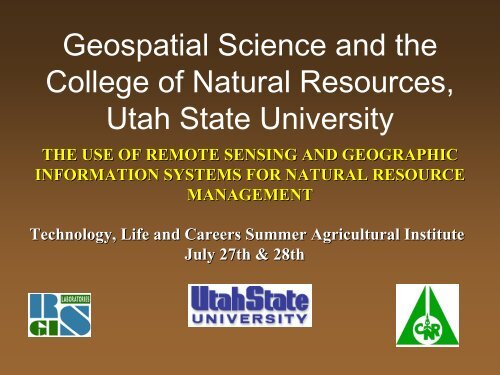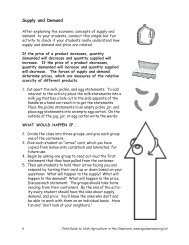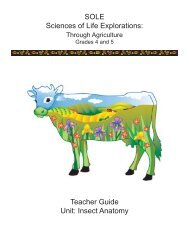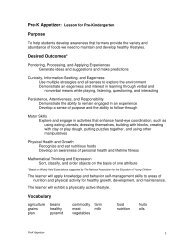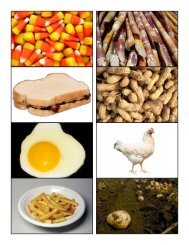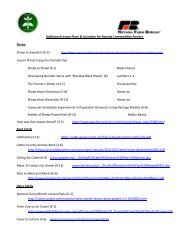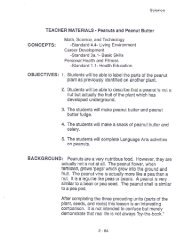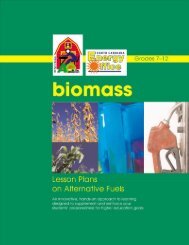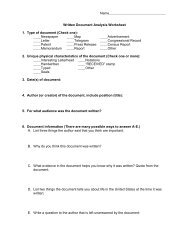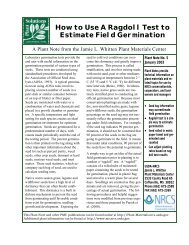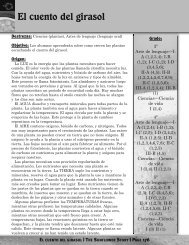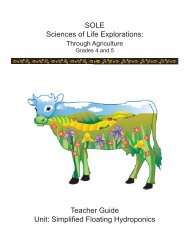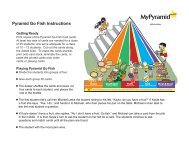Field Experiences Remote Sensing GPS/GIS Applications in ...
Field Experiences Remote Sensing GPS/GIS Applications in ...
Field Experiences Remote Sensing GPS/GIS Applications in ...
Create successful ePaper yourself
Turn your PDF publications into a flip-book with our unique Google optimized e-Paper software.
Geospatial Science and the<br />
College of Natural Resources,<br />
Utah State University<br />
THE USE OF REMOTE SENSING AND GEOGRAPHIC<br />
INFORMATION SYSTEMS FOR NATURAL RESOURCE<br />
MANAGEMENT<br />
Technology, Life and Careers Summer Agricultural Institute<br />
July 27th & 28th
The unique perspective of<br />
remotely sensed data<br />
provides whole landscape<br />
<strong>in</strong>terpretation and<br />
analysis possibilities<br />
This allows us to evaluate<br />
the context of field data<br />
and possibly extrapolate<br />
these data to other<br />
locations
Early <strong>Remote</strong> <strong>Sens<strong>in</strong>g</strong><br />
Platforms
B-17 Fly<strong>in</strong>g Fortress<br />
•• US US 8th 8th Air Air Force Force<br />
B-17 B-17 Fly<strong>in</strong>g Fly<strong>in</strong>g<br />
Fortress Fortress over over<br />
Berl<strong>in</strong>, Berl<strong>in</strong>, Germany Germany <strong>in</strong> <strong>in</strong><br />
World World War War II. II.<br />
Aerial Aerial photographs photographs<br />
capture capture bombs bombs<br />
from from the the unseen unseen B- B-<br />
17 17 crash crash through through<br />
the the port port horizontal horizontal<br />
stabilizer. stabilizer.<br />
Jensen,<br />
Jensen,<br />
2000<br />
2000
U-2<br />
Famous as a spy plane, the U-2 is now used as a research<br />
platform
SR-71 Blackbird
Terra<br />
The Terra Platform is the newest <strong>in</strong> a series of highquality<br />
Earth view<strong>in</strong>g remote sens<strong>in</strong>g platforms designed<br />
to monitor Earths natural resources.
Global Hawk<br />
The Global Hawk UAV belongs to a new series of<br />
advanced and autonomous remote sens<strong>in</strong>g platforms<br />
able to fly across the globe with little or no supervision.
Pathf<strong>in</strong>der<br />
Able to fly at 80,000 feet ASL, these new UAV’s are<br />
lightweight, autonomous, and can carry significant payloads<br />
for it’s size and weight.
Helios<br />
With a 247 foot w<strong>in</strong>gspan, Helios can fly above 93,000 feet ASL. Future models<br />
will be designed to stay aloft for more than 6 months. The Helios weighs<br />
approximately 1,600lbs which translates to about .81lbs/sq. ft. of w<strong>in</strong>g. The top<br />
speed is 27mph with a take-off speed of ~15 mph. The aircraft is solar powered<br />
with a polymer-electrolyte (oxygen/hydrogen) fuel cell for night time activity.
What Can We See??
April 28 th , 2004<br />
Fires <strong>in</strong> Ch<strong>in</strong>a and Russia caused<br />
mostly by agricultural burn<strong>in</strong>g.<br />
captured by the Moderate<br />
Resolution Imag<strong>in</strong>g Spectrometer<br />
(MODIS).
April 28th, 2004<br />
Dust storm <strong>in</strong> Nevada captured<br />
by the Moderate Resolution<br />
Imag<strong>in</strong>g Spectrometer (MODIS)
Flood<strong>in</strong>g along the Mississippi River,<br />
Arkansas<br />
April 17 th , 2004 April 27 th , 2004
1 meter digital black and<br />
white imagery<br />
4 meter digital color<br />
imagery
QuickBird<br />
Little Cottonwood Canyon (Snowbird and Alta, Utah) 280mi ASL, 2.3ft resolution
What Can We Do With It?
Between Year Change Detection – Urban Environment<br />
1972<br />
1982<br />
1993<br />
1997
History and<br />
Resource Monitor<strong>in</strong>g<br />
Before: Alta, Utah<br />
July 3, 1885<br />
(Courtesy Utah State<br />
Historical Society)<br />
After 115 years:<br />
Alta, Utah<br />
July 3, 2002<br />
(Courtesy Dr. Chris<br />
Cl<strong>in</strong>e Westm<strong>in</strong>ster<br />
College)
Seasonal Changes <strong>in</strong> Vegetation<br />
July-Aug<br />
Sept-Oct<br />
ETM Bands 5, 4, 3 ETM Bands 5, 4, 3
Land Cover Mapp<strong>in</strong>g<br />
Satellite imagery allows us the ability to identify and map land<br />
cover features over large or small landscapes
Mapp<strong>in</strong>g land cover us<strong>in</strong>g remote sens<strong>in</strong>g requires a<br />
significant amount of field work cover<strong>in</strong>g all possible land<br />
cover types <strong>in</strong> the area to be mapped
<strong>Field</strong> Data Collection for the<br />
Southwest Regional GAP<br />
Land Cover Map
Global Land Cover Classification Systems<br />
Materials for this lecture were extracted from the Global Land Cover Characterization Web page<br />
(http://edcdaac.usgs.gov/glcc/glcc.html)
AGRICULTURE<br />
IKONOS Satellite Images of Wheat <strong>Field</strong>s<br />
IKONOS<br />
False<br />
Color<br />
May 22, 2000 (Jo<strong>in</strong>t<strong>in</strong>g) June 6, 2000 (Boot) June 28, 2000 (Flower<strong>in</strong>g)<br />
IKONOS<br />
NDVI<br />
May 22, 2000 (Jo<strong>in</strong>t<strong>in</strong>g) June 6, 2000 (Boot) June 28, 2000 (Flower<strong>in</strong>g)
Identification of Potential <strong>Field</strong> Problems<br />
June 23, 1999<br />
July 9, 1999<br />
•August 9, 1999<br />
Unsupervised<br />
Supervised
Estimated Fertilizer<br />
Application Map from June 6,<br />
2000<br />
Yield Prediction Map from<br />
June 6, 2000<br />
Legend<br />
Red 53 gallons USA/acre, Yellow 32.8 gallons USA/acre, Cyan<br />
adequate, Royal Blue luxurious<br />
Legend<br />
0-80 bu/acre Blue, 80-90 bu/acre Turquoise , 90-100 bu/acre Aqua,<br />
100-110 bu/acre Green, 110-120 bu/acre Yellow, 120-130 bu/acre Gold,<br />
130-140 bu acre Orange, 140-150 bu/acre Red, 150+ bu/acre Maroon
<strong>Field</strong> Validation and<br />
Model Tra<strong>in</strong><strong>in</strong>g<br />
•Pictures of the Transects<br />
•Visual Observations<br />
‣Color Differences<br />
‣Number of Tillers Per Plant<br />
‣Height of Plants<br />
‣Vegetation Thickness<br />
Always Necessary!!!
Chlorophyll Meter Method<br />
• SPAD 502 chlorophyll meter made by<br />
M<strong>in</strong>olta<br />
• The meter was clamped on a leaf and<br />
pressed to give a read<strong>in</strong>g of the amount<br />
of chlorophyll <strong>in</strong> the leaf on a 1-100<br />
scale<br />
• Samples from the middle of the top leaf<br />
• Thirty samples were taken and averaged<br />
for each data po<strong>in</strong>t.
Natural Resource Management<br />
Wetland Del<strong>in</strong>eation
Critical Habitat Model<strong>in</strong>g
Net Primary Productivity and<br />
Climate Change Monitor<strong>in</strong>g<br />
January July October<br />
Feb. Mar. Apr. May. Jun. Aug. Sept. Oct. Nov. Dec.<br />
A time series of 1-km Advanced Very High Resolution Radiometer (AVHRR)<br />
data spann<strong>in</strong>g April 1992 through March 1993 was used to model land cover<br />
us<strong>in</strong>g phenological characteristics modeled us<strong>in</strong>g a Normalized Difference<br />
Vegetation Index (NDVI) of each date.<br />
In addition to monthly AVHRR NDVI, other key geographic data <strong>in</strong>cluded<br />
digital elevation data, ecoregion <strong>in</strong>terpretations, and country or regional-level<br />
vegetation and land cover maps.
MONITORING PHENOLOGICAL<br />
FLUX
Geographic Information Systems<br />
High Resolution Imagery<br />
Medium Resolution Imagery<br />
Land Use / Land Cover<br />
Geology<br />
Slope Categories<br />
Slope Aspect<br />
Elevation<br />
Data layers are geographically<br />
registered with<strong>in</strong> a database<br />
structure to allow queries between<br />
layers to generate a better<br />
understand<strong>in</strong>g of landscape dynamics<br />
and relationships.
Location X<br />
Basic <strong>GIS</strong> Database<br />
Outbreaks<br />
Municipal Boundaries<br />
School Districts<br />
Census Blocks<br />
Regions<br />
Property Boundaries<br />
Streets<br />
Hydrology<br />
County Boundaries<br />
HazMat Sites<br />
<strong>GIS</strong> Facilitates<br />
Data Integration<br />
Location can be used as the<br />
central organiz<strong>in</strong>g and <strong>in</strong>tegrat<strong>in</strong>g<br />
pr<strong>in</strong>ciple for data <strong>in</strong> multiple<br />
databases<br />
85% of government data is<br />
‘geospatial’. It relates directly to<br />
features that have a location, or, to<br />
<strong>in</strong>dividuals / entities that have an<br />
address location.<br />
Population Density<br />
Aerial Imagery


